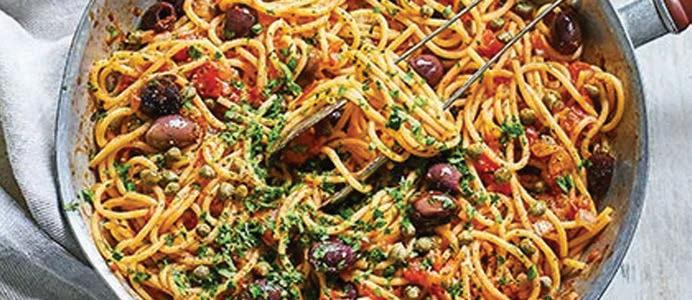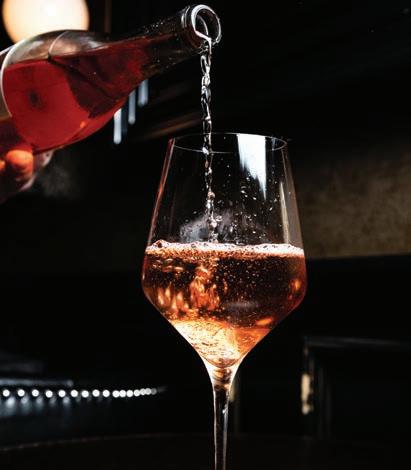
5 minute read
Food & Drink
Food & Drink Me Come Dine With
Apple & hazelnut galette
Advertisement
Prep: 30 mins Cook:55 mins plus at least 30 mins chilling
Tailor our apple galette to your taste – add blackberries, swap the hazelnuts for almonds or pecans, or use pears or peaches instead of apple, if you like.
Ingredients
• 50g light brown soft sugar, plus extra for sprinkling • ½ lemon, zested and juiced • 1 tbsp corn our • 1 tbsp maple syrup • 3 Bramley apples, peeled, cored, halved and thinly sliced • 20g hazelnuts, roughly chopped • double cream, to serve

For the pastry • 80g hazelnuts • 2 tbsp icing sugar • 125g spelt our • 175g plain our, plus extra for dusting • 150g cold butter, cubed • 1 egg, beaten
Method
STEP 1
First, make the pastry. Blitz the hazelnuts and sugar in a food processor until nely chopped. Add the spelt and plain ours, butter and a good pinch of salt, and blitz again until all of the butter has been incorporated and the mixture is sandy. With the motor running, drizzle in 1-2 tbsp cold water until the dough starts to form in clumps. Squeeze a little between your ngers – if it feels like it will come together, tip the mixture onto your work surface and knead brie y into a ball. Shape into a disc, wrap and chill for 30 mins or overnight.
STEP 2
If the pastry has been chilled for longer than 30 mins, let it come to room temperature for 20 mins before rolling. Mix the brown sugar, lemon zest, corn our and maple syrup together in a large bowl. Add the apples and toss well. Set aside while you roll out the pastry.
STEP 3
Heat the oven to 180C/160C fan/gas 4. Dust a sheet of baking parchment large enough to line a large baking tray with our, then roll the pastry out to a roughly 30cm circle on top of the parchment. e pastry will crack and crumble a little as you roll it, but just keep pushing the edges back together – don’t worry if it looks rustic. Slide the pastry on its parchment onto the baking tray. Pile the apple slices into the centre of the pastry circle using your hands, letting any excess syrup drip back into the bowl as you do (save the syrup for later). Be sure to leave a clear 2cm border around the edge. Use the baking parchment to help you lift the edges of the pastry over the apples, leaving the most of the apples exposed. Pinch together any cracks around the edge to make a rustic pastry border.
STEP 4
Brush the pastry edge with some beaten egg, sprinkle with a little extra brown sugar and scatter over the hazelnuts. Bake for 50-55 mins until golden brown. Meanwhile, pour any leftover syrup from the apples into a small saucepan and bubble for a few minutes until syrupy. When the galette is cooked and still hot, brush the syrup over the top. Leave to cool for at least 30 mins, then serve warm with cold cream. Will keep in the fridge for up to two days, or freeze in well-wrapped slices for up to two months.

Spaghetti puttanesca

Prep: 15 mins Cook: 20 mins Serves: 4 Ingredients
•3 tbsp olive oil •1 onion, nely chopped •2 large garlic cloves, crushed •½ tsp chilli akes (optional) •400g can chopped tomatoes •5 anchovy llets, nely chopped •120g pitted black olives •2 tbsp capers, drained •300g dried spaghetti •½ small bunch of parsley, nely chopped
Method
STEP 1
Heat the oil in a non-stick pan over a medium-low heat. Add the onion along with a generous pinch of salt and fry for 10 mins, or until soft. Add the garlic and chilli, if using, and cook for a further minute.
STEP 2
Stir the tomatoes, anchovies, olives and capers into the onion, bring to a gentle simmer and cook, uncovered, for 15 mins. Season to taste.
STEP 3
Meanwhile, bring a large pan of salted water to the boil. Cook the spaghetti following pack instructions, then drain and toss with the sauce and parsley.

e health bene ts of drinking wine
While excessive and binge drinking should be avoided, moderate drinking (no more than ve units per week) may have some bene ts for heart health, at least for certain individuals. However, sorting fact from ction isn’t easy. ere’s long been discussion about the risks and rewards that drinking wine has on your health. So, what’s true and what’s not?
It does appear that wine – particularly red – provides plant compounds that have antioxidant properties. ese include quercetin and resveratrol, which some believe may play a part in helping prevent heart disease. However, there are many other health-promoting foods and drinks that are better choices.
Some research suggests that ‘moderate’ drinking (no more than ve units per week) may o er some protection against heart disease, but primarily for men aged over 40 and post-menopausal women (and only when consumption is limited to ve units a week – that’s just two standard glasses of wine). ere is little evidence that drinking wine or other alcohol will improve the health of younger people who are less at risk of heart disease. Taking this into account, a large global study published in the Lancet in 2018 con rmed the ndings of previous research that states there is no safe level of alcohol consumption. e science currently recommends that if you do choose to drink alcohol and you drink most weeks, you should limit your consumption to no more than 14 units a week. If this is a normal amount for you, spread your drinking over three days or more while enjoying some alcohol-free days during the week.
Binge drinking refers to the consumption of a lot of alcohol over a short period of time. It’s classed as eight units of alcohol in a single session for men or six units for women.
What are the risks of binge drinking?
Binge drinking is especially harmful and may damage your brain. For men and women in their 20s, drinking heavily may also contribute to osteoporosis later in life.
Alcohol consumption is thought to be responsible for about 3% of all cancer cases – people who drink three or more alcoholic drinks (equivalent to six units) a day are more likely to develop cancer of the mouth, larynx or oesophagus.
High levels of alcohol consumption may also impact your nutritional status by inhibiting the absorption of certain nutrients, including the B group of vitamins (most notably, folate and B12). is can make you more vulnerable to heart disorders, including high blood pressure and stroke, regardless of whether you are in a high-risk group.
Alcohol disrupts sleep, clouds judgement and potentially interacts with prescribed medication, so keeping to low-risk guidelines is without doubt the most sensible approach. Or better still, avoid it altogether – this should be the case if you are pregnant, trying to conceive, have a pre-existing health condition or take medication that may be a ected by alcohol.







